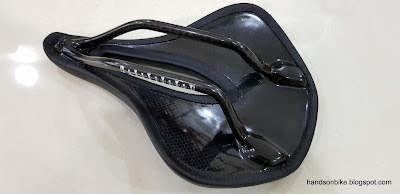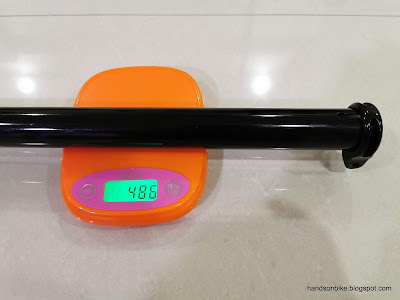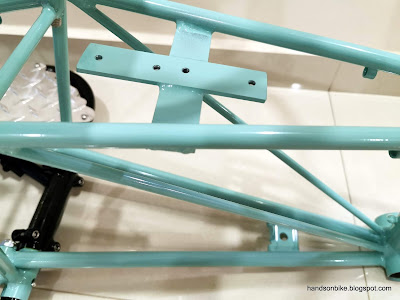1) Handlepost clamp diameter is 25.4 mm, instead of the usual 28.6 mm of a steerer tube. In other words, a standard stem cannot be clamped directly onto the handlepost. Instead, a shim is needed to use a standard stem on the handlepost.
2) Front brake mount is non standard, as a 180 mm brake adapter is needed to use with a 160 mm diameter rotor.
3) Seat post clamp diameter is 28.6 mm, instead of the more common 27.2 mm, 30.8 mm or 31.6/8 mm. This means that the choice of seat posts are severely limited.
To elaborate more on the seat post clamp diameter, I am referring to the size of the seat post that will fit inside the seat mast, which is the part that is inserted into the frame.
Credit to MyBikeShop and Bike Friday, they actually provided a seat post shim, to convert the non-standard 28.6 mm diameter to a common 27.2 mm diameter. The thing was, I did not know this, and I had already got a 28.6 mm diameter seat post. Therefore, I removed the shim and used the 28.6 mm seat post.
Shim is needed to convert the seat mast inner diameter from 28.6 mm to 27.2 mm. That will allow a standard 27.2 mm diameter seat post to be used.
The only choices of 28.6 mm diameter seat post were the cheap but heavy type from Taobao, or the nicer and lighter ones by Thomson.
Thomson Elite seat post, in 28.6 mm diameter x 330 mm length. I have another Thomson seat post on the Fabike C3 and I like it a lot due to the low weight.
Problem is, this Thomson seat post is not lightweight at all! Although it is shorter and smaller in diameter than the other seat post, it is quite a bit heavier!
Reason is due to the very thick walls used in the tube. Comparing it to the other 31.6 mm diameter seat post, this is very thick and probably over built.
The reason that Bike Friday uses a 28.6 mm diameter for the seat post is so that a standard stem can be clamped onto the seat post, so that a handlebar can be mounted behind as shown. I understand this rationale and can accept this. Ironically, this is also the problem that the handlepost has, where the clamp diameter is not the usual 28.6 mm diameter.
Handlebar mounted behind the seat post, for older children or even adults.
I am not happy with this Thomson seat post, as it is expensive and yet not lightweight at all, unlike the previous one I had. Maybe the thick walls of this 28.6 mm diameter seat post are to allow a stem to be clamped onto it without crushing it.
As for the saddle, I got one from Ascent Bikes, at the same time that I got the crankset, wheelset and handlebar from them. I liked the saddle which I tested on the Ascent Bolt mini velo, which is why I wanted to get this saddle for the Bike Friday Haul-A-Day.
Wide and short saddle, with quite a bit of padding.
Side view of the saddle.
What is different from the saddle I tested on the Ascent Bolt mini velo is that this is the carbon version, with a carbon shell and seat rails.
Carbon rails bonded to the carbon shell.
Width of this saddle is 160 mm...
...much wider than the 130 mm of the Selle Italia SLR Titanium Saddle.
Length of the carbon saddle is 240 mm...
...also much shorter than the 275 mm of the Selle Italia SLR Titanium Saddle.
Weight is 183 grams, which is actually quite good! Midway between the weight of the top end SLR Kit Carbonio Flow saddle and the heavier SLS Kit Carbonio Flow saddle.
Lastly, to make it easier to adjust the seat post and seat mast height, I wanted to change the seat post clamps to the quick release type.
The bottom clamp (between seat mast and seat tube) is 34.9 mm diameter, while the top clamp (between seat post and seat mast) is 31.8 mm diameter. I could not find any nice seat post clamps, other than the ones from Hope which uses a brass bushing for better clamping force.
Hope quick release seat post clamps, in 31.8 mm and 34.9 mm diameters.
Bottom seat clamp installed!
The problem is, when the quick release seat clamp is used, I could not secure the seat mast even when the lever is adjusted to be very tight. The seat mast has already been scratched by the seat tube due to the tight clamping force, but it will still rotate when I twist the saddle.
I have no choice but to change the bottom clamp back to the original type that uses an Allen key. The original clamp is able to secure the seat mast tightly.
Original clamp to secure the seat mast onto the seat tube. No slippage when this clamp is used.
Top quick release clamp is able to fix the seat post securely, so there is no issue with this. At least I am able to adjust the seat post height easily, although adjusting the seat mast will require a 5 mm Allen key.
Final set up, with the short and wide saddle, the Thomson seat post, and a Hope seat post clamp.
I am happy with the saddle, as it is wide and short, which is comfortable to use. Not so with the Thomson seat post, as it is expensive but still quite heavy. Finally, I was only able to use 1 out of 2 seat post clamps, as the bottom one does not work well.
Bit by bit, the bike is coming together, and it will be ready to testing soon!































































